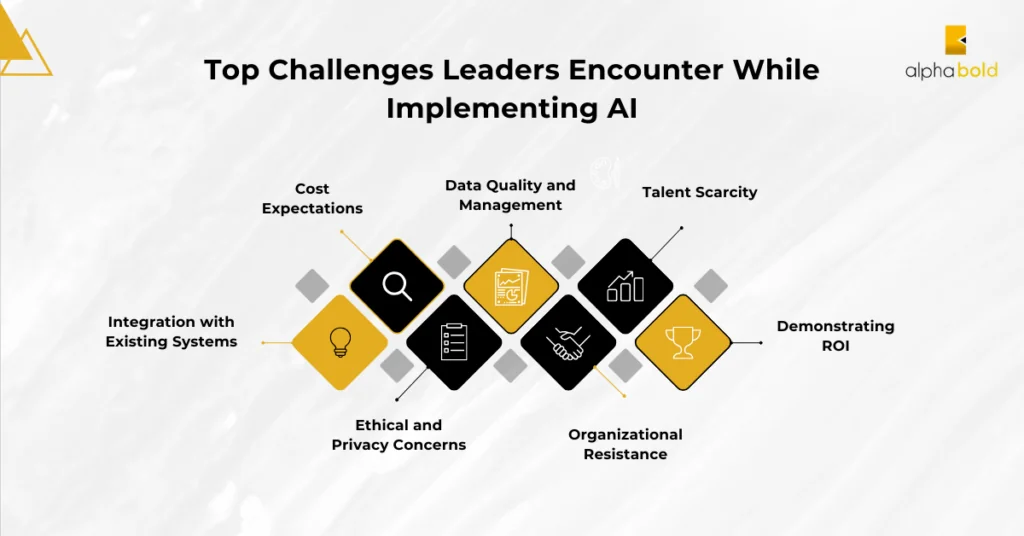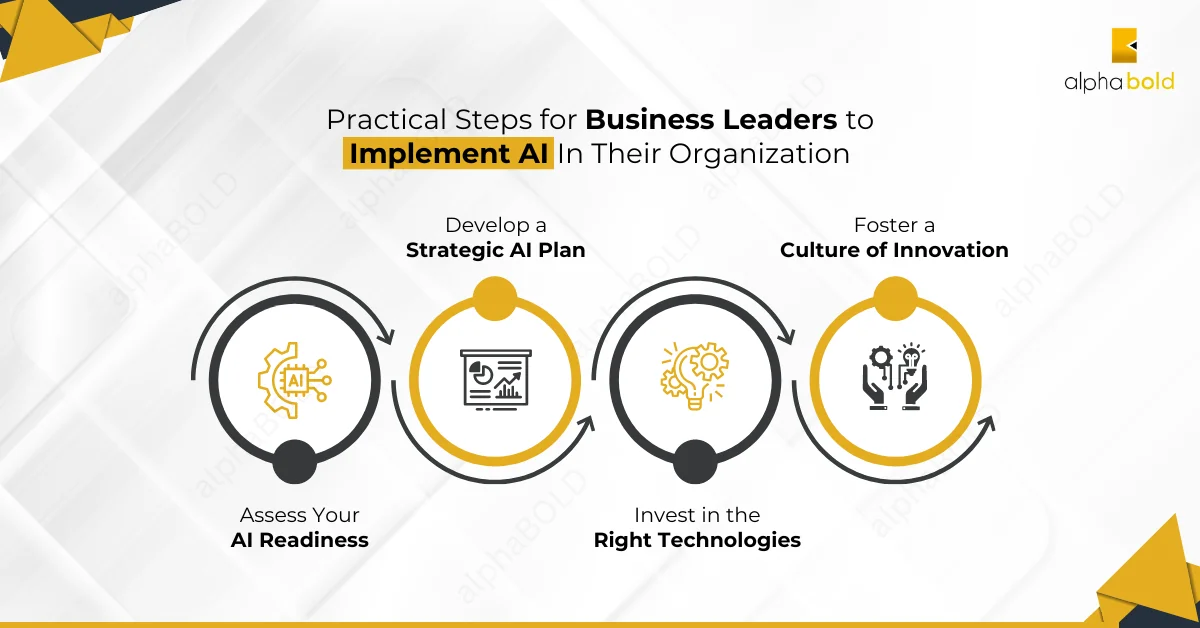Introduction
This blog post is a guide to four actionable steps for business leaders to implement AI in their business and harness its full potential.
Artificial intelligence (AI) is becoming a vital force behind business transformation instead of just being considered scientific fiction. A McKinsey Global Survey indicates that 56% of businesses use AI in at least one function, and those that do so are more likely to experience higher revenue.
Businesses like Coca-Cola, Amazon, and Netflix have been early adopters of AI to improve decision-making, accelerate business processes, and spur creativity. However, a lot of business leaders are still having trouble realizing how to use AI to its greatest advantage in their businesses.
If you are the decision maker for your business, this blog will bridge that gap for you and will provide you with actionable tips to make AI a major stakeholder in your business operations.
Challenges Leaders Encounter While Implementing Business Strategies for AI Implementation

Despite its enormous potential, business leaders face several difficulties and obstacles while using AI. Let’s discuss the most common obstacles today’s business leaders can face while working around the business strategies for AI implementation:
- Cost Expectations: For business leaders, the cost is most likely the factor that will make or break a company’s AI journey. Despite all the promises made by such solutions, the money is spent mostly on their deployment, maintenance, and potential upgrades. A firm’s owner should constantly be prepared for unforeseen expense increases. More resources, including specialized staff, hardware, software, etc., may be needed to sustain the current AI systems more often than initially anticipated. Furthermore, resources may need further training to keep up with the complicated models and constantly changing algorithms.
- Data Quality and Management: Several companies face challenges ensuring the accuracy, consistency, and accessibility of their data. A Deloitte survey found that 39% of corporate executives saw data quality as a significant impediment to the adoption of AI. Poor data quality might result in inaccurate insights and reduced efficacy of AI models.
- Talent Scarcity: Building effective AI teams is challenging for businesses due to a severe scarcity of experienced AI specialists. According to Gartner, by 2025, the adoption of AI in major enterprises will be 30% slower due to a lack of expertise in AI positions. This gap in talent could be a significant barrier to AI adoption.
- Integration with Existing Systems: Integration of AI solutions with legacy systems can be difficult and resource-intensive. This challenging process might impede the adoption of AI and impact its effectiveness.
- Ethical and Privacy Concerns: The use of AI creates threats to data privacy and ethical concerns, such as prejudice in AI systems. Resolving these issues is essential to fostering confidence and guaranteeing adherence to rules.
- Organizational Resistance: The adoption of AI could be hampered by organizational resistance to change. Workers can be weary of new processes due to a lack of faith in emerging technology or fear of losing their jobs.
- Demonstrating ROI: It can be difficult to demonstrate AI initiatives’ return on investment (ROI), particularly in their early phases. According to PwC’s Global AI Study, artificial intelligence has enormous potential to develop businesses; by 2030, it can boost the world economy by up to $15.7 trillion. To maintain investment, business executives must provide measurable returns.
Management can create a more favorable atmosphere for AI adoption and optimize its advantages by tackling these issues and difficulties early in the process of coming up with business strategies for AI implementation. The next section offers practical steps for business leaders to implement AI in their organization and to avoid hiccups in the implementation journey.

Step 1: Assess Your AI Readiness
Take a Readiness Assessment:
Assessing your workforce pool, technological stack, and data infrastructure should come first. Use models such as the AI Readiness Model to determine where you stand. Determine the domains in which you fall short, such as data quality, technological proficiency, or AI literacy.
Create a Vision and an Action Plan:
Clearly state your goals for utilizing AI. Your AI projects should align with your company objectives, whether they are boosting customer experiences, increasing operational efficiency, or stimulating innovation. Research published in the MIT Sloan Management Review says that 76% of CEOs think AI is essential to their company’s business plan. Specific goals will help your AI strategy flow and ensure that everything you do is done with a reason.
Include Stakeholders in the Process:
Step 2: Develop a Strategic AI Plan
Begin with Pilot Projects:
Make an Investment in Data Management:
A strong data management system is the foundation of every AI project. Ensure you have data pipelines to gather and combine information from several sources. According to a McKinsey analysis, the likelihood of significant benefit from AI is 2.5 times higher for firms with a robust data governance structure.
Adopt data governance procedures to preserve your data’s security, consistency, and correctness. Coca-Cola, for example, made significant investments in data integration to help with its supply chain efficiency and AI-driven marketing initiatives.
Select Suitable Technologies:
Choose AI platforms and technologies based on what you require. Consider elements like support, scalability, and usability. Choose between working with suppliers or developing AI solutions internally. For example, Amazon powers its AI-driven logistics and customer support operations using a mix of in-house development and outside solutions.
Discover Tailored AI Solutions for Your Business
Every business is unique, and so are your AI needs. At AlphaBOLD, we specialize in creating customized AI strategies that align with your business goals. Discover the steps for business leaders to implement AI effectively. Request a consultation now, and let us help you unlock new opportunities, enhance customer experiences, and achieve operational excellence with AI.
Request a ConsultationStep 3: Invest in the Right Technologies
Use AI Solutions That Are Scalable:
Concentrate on Automation:
AI can be employed to automate monotonous jobs so that staff members can concentrate on higher-value work. According to Forrester, by 2025, AI-driven automation will add new employment equivalent to 9% of the workforce. Understanding the steps for business leaders to implement AI can significantly enhance this process.
Use intelligent automation to increase productivity and optimize operations. With AI, Coca-Cola automates supply chain procedures to cut expenses and boost operational effectiveness.
Improve Decision-Making:
At this stage, access the role of AI in business decision making and how it can potentially improve the results. Predictive insights from AI-powered analytics can assist you in making data-driven choices. Use AI systems that facilitate quick decision-making by providing real-time insights and suggestions. To improve customer happiness, Netflix uses artificial intelligence (AI) algorithms to evaluate user data and forecast their watching behaviors. This allows for tailored content recommendations.
Looking for capable AI solution partners and talent? This might help Key Skills and Competencies of A Successful AI Project Coordinator.
Step 4: Foster a Culture of Innovation
Promote AI Literacy:
Provide upskilling training courses on AI principles, instruments, and applications for employees. Within the company, choose advocates for AI who may spearhead efforts and disseminate information. A Deloitte survey indicates that 94% of corporate executives believe AI is essential to their approach to innovation. For example, Amazon invests in ongoing education initiatives to guarantee that its employees have access to the newest AI capabilities.
Are you from AEC industry looking for latest AI applications in your sector? Here’s everything you need to know: The Revolutionary Impact of AI in the AEC Industry.
Promote Experimentation:
Encourage Cooperation:
Cooperation between business divisions, engineers, and data scientists must be promoted to create AI solutions. Assist startups, research institutes, and outside specialists to maintain your leadership position in AI innovation.
Conclusion
Leaders today need deliberate business strategies for AI implementation to fully realize the potential of the latest tech. The process starts with determining your preparedness, investing in the appropriate technology, and encouraging a culture of creativity. Business executives can use AI to create change and accomplish their objectives by implementing the four practical steps for business leaders to implement AI in this blog.
If you want to stay ahead of the competition, it’s crucial to keep up with the most recent developments in AI, as well as best practices and ethical issues. To navigate the AI ecosystem and its complexities effectively, research and learn from the insights provided by industry professionals and academic research. Following these steps, you’ll be well-positioned to lead your company into the future and realize AI’s full potential if you accomplish this.
Maximize Your Artificial Intelligence ROI with AlphaBOLD
Worried about the ROI of your AI investments? Let AlphaBOLD help you maximize returns and drive tangible business value. Book a consultation with our AI specialists today to discuss your goals and discover tailored strategies for achieving exceptional ROI. Invest in success with AlphaBOLD’s proven AI solutions.
Request a ConsultationExplore Recent Blog Posts







